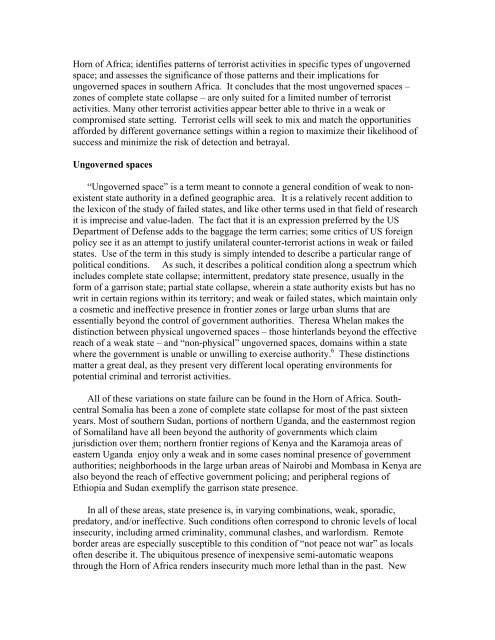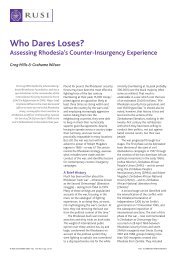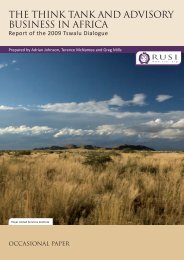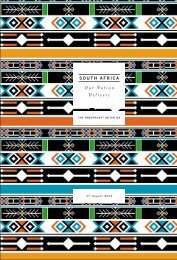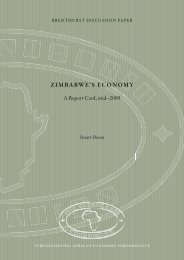Terrorist Activities in Ungoverned Spaces - The Brenthurst Foundation
Terrorist Activities in Ungoverned Spaces - The Brenthurst Foundation
Terrorist Activities in Ungoverned Spaces - The Brenthurst Foundation
Create successful ePaper yourself
Turn your PDF publications into a flip-book with our unique Google optimized e-Paper software.
Horn of Africa; identifies patterns of terrorist activities <strong>in</strong> specific types of ungoverned<br />
space; and assesses the significance of those patterns and their implications for<br />
ungoverned spaces <strong>in</strong> southern Africa. It concludes that the most ungoverned spaces –<br />
zones of complete state collapse – are only suited for a limited number of terrorist<br />
activities. Many other terrorist activities appear better able to thrive <strong>in</strong> a weak or<br />
compromised state sett<strong>in</strong>g. <strong>Terrorist</strong> cells will seek to mix and match the opportunities<br />
afforded by different governance sett<strong>in</strong>gs with<strong>in</strong> a region to maximize their likelihood of<br />
success and m<strong>in</strong>imize the risk of detection and betrayal.<br />
<strong>Ungoverned</strong> spaces<br />
“<strong>Ungoverned</strong> space” is a term meant to connote a general condition of weak to nonexistent<br />
state authority <strong>in</strong> a def<strong>in</strong>ed geographic area. It is a relatively recent addition to<br />
the lexicon of the study of failed states, and like other terms used <strong>in</strong> that field of research<br />
it is imprecise and value-laden. <strong>The</strong> fact that it is an expression preferred by the US<br />
Department of Defense adds to the baggage the term carries; some critics of US foreign<br />
policy see it as an attempt to justify unilateral counter-terrorist actions <strong>in</strong> weak or failed<br />
states. Use of the term <strong>in</strong> this study is simply <strong>in</strong>tended to describe a particular range of<br />
political conditions. As such, it describes a political condition along a spectrum which<br />
<strong>in</strong>cludes complete state collapse; <strong>in</strong>termittent, predatory state presence, usually <strong>in</strong> the<br />
form of a garrison state; partial state collapse, where<strong>in</strong> a state authority exists but has no<br />
writ <strong>in</strong> certa<strong>in</strong> regions with<strong>in</strong> its territory; and weak or failed states, which ma<strong>in</strong>ta<strong>in</strong> only<br />
a cosmetic and <strong>in</strong>effective presence <strong>in</strong> frontier zones or large urban slums that are<br />
essentially beyond the control of government authorities. <strong>The</strong>resa Whelan makes the<br />
dist<strong>in</strong>ction between physical ungoverned spaces – those h<strong>in</strong>terlands beyond the effective<br />
reach of a weak state – and “non-physical” ungoverned spaces, doma<strong>in</strong>s with<strong>in</strong> a state<br />
where the government is unable or unwill<strong>in</strong>g to exercise authority. 6 <strong>The</strong>se dist<strong>in</strong>ctions<br />
matter a great deal, as they present very different local operat<strong>in</strong>g environments for<br />
potential crim<strong>in</strong>al and terrorist activities.<br />
All of these variations on state failure can be found <strong>in</strong> the Horn of Africa. Southcentral<br />
Somalia has been a zone of complete state collapse for most of the past sixteen<br />
years. Most of southern Sudan, portions of northern Uganda, and the easternmost region<br />
of Somaliland have all been beyond the authority of governments which claim<br />
jurisdiction over them; northern frontier regions of Kenya and the Karamoja areas of<br />
eastern Uganda enjoy only a weak and <strong>in</strong> some cases nom<strong>in</strong>al presence of government<br />
authorities; neighborhoods <strong>in</strong> the large urban areas of Nairobi and Mombasa <strong>in</strong> Kenya are<br />
also beyond the reach of effective government polic<strong>in</strong>g; and peripheral regions of<br />
Ethiopia and Sudan exemplify the garrison state presence.<br />
In all of these areas, state presence is, <strong>in</strong> vary<strong>in</strong>g comb<strong>in</strong>ations, weak, sporadic,<br />
predatory, and/or <strong>in</strong>effective. Such conditions often correspond to chronic levels of local<br />
<strong>in</strong>security, <strong>in</strong>clud<strong>in</strong>g armed crim<strong>in</strong>ality, communal clashes, and warlordism. Remote<br />
border areas are especially susceptible to this condition of “not peace not war” as locals<br />
often describe it. <strong>The</strong> ubiquitous presence of <strong>in</strong>expensive semi-automatic weapons<br />
through the Horn of Africa renders <strong>in</strong>security much more lethal than <strong>in</strong> the past. New


